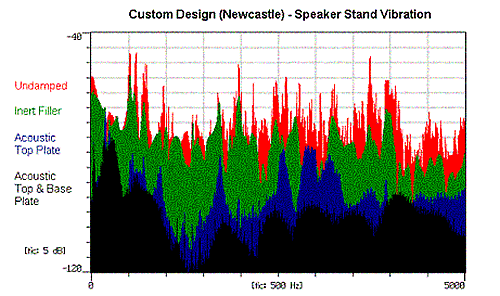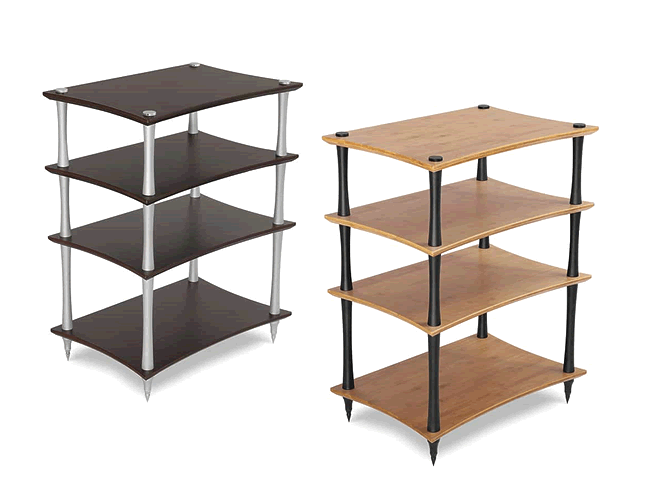 @kemela
@kemela
Custom Design is a family-run company located in Newcastle upon Tyne - a major powerhouse in the UK's industrial revolution - that designs and manufactures one of the most comprehensive ranges of innovative, specialist Hi-Fi loudspeaker stands, Hi-Fi racks and isolation products in the inudstry.
Custom Design has more than 30 years of design and manufacturing experience and uses modern precision manufacturing techniques and the highest quality materials. New designs are continually being added to an already extensive portfolio of award winning contemporary and classic products all making significant improvements to sound quality with pleasing aesthetics to compliment your room.
Choice of materials and green friendly products
Hardwoods, MDF, steel, glass, polymers and in-house developed materials are all used in practical ways for best sonic performance while keeping costs in a resonable range. Steel transfers energy better than extruded aluminum and glass is denser than wood or MDF. Loudspeaker enclosures, turntable platters and sound proofing windows use glass in thicknesses that don't behave like a ringing wine glass.
Custom Design's philosophy is not only to question and challenge their own ideas in depth, executing, fabricatiing and finishing with the greatest attention to detail, but also to develop and grow business with a social responsibility and environmentally friendly practices for every product designed and manufactured.
Resonance control: Acoustic Steel and Inert Filler
Acoustic Steel™, a laminated steel composite that dissipates vibrational energy by converting it into heat, is featured in all but the less expensive loudspeaker stands, and in Custom Design's Isolation platforms (iRAPs).

Inert Filler is available as an optional upgrade for metal tube stands to reduce resonance and to mass load the stand. It is a better filler than dry sand or lead shot as more vibrational evergy is converted into heat because of the surface area contact of the irregular filler granules.
The graph shows the reduction of resonance when the support column of the popular RS 300 speaker stand is filled with 'Inert Filler'. More impressive however is the reduction when standard steel top and and base plates are switched for ones made from 'Acoustic Steel'.
The y-axis of the graph is in steps of 5dB and over much of the frequency spectrum to 5kHz there is a 40dB reduction; vibrations are reduced by 100x from speaker platform to floor spike and vice versa. With the addition of an Acoustic steel base plate the reduction is 1000x at some frequencies!

Custom Design RS series Speaker Stands
- Classic 24" loudspeaker stands featuring one, two, three, or four 2" or 3" columns.
- RS200&202: 150mm x 150mm x 3mm top plate; RS203&204: 165mm x 180mm x 4mm Acoustic Steel top plate. 3mm steel base plates. M6 fixing bolts
- RS300,302: 165mm x 180mm x 4mm top plate; RS303&304: 165mm x 180mm x 4mm Acoustic Steel top plate. 4mm steel base plates. M8 fixing bolts
- Use with optional Custom Design Inert Filler to reduce resonance and add mass
- Standard finishes: Black or White Satin fine crinkle powder coat
- Custom heights and top plates available
- Pricing, options and availability of RS stands
Custom Design SQ Speaker Stands
- Classic 24" loudspeaker stands featuring one, two, or four 2" square wood or steel columns.
- 165mm x 180mm x 4mm Acoustic Steel top plate. 4mm steel base plates. M8 fixing bolts
- Use with optional Custom Design Inert Filler to reduce resonance and add mass
- Standard steel finishes: Black or White Satin fine crinkle powder coat
- Standard wood finishes: Oak, Cherry, Walnut, Satin Black & Satin White
- Custom top plates, and brand specific models available. Currently only available in 24" height
- Pricing, options and availability of SQ stands
Custom Design FS Speaker Stands
- Custom Design's Signature popular ultra rigid loudspeaker stand with one, two, or four 3" round steel central column(s) with four 1" round steel satelite columns
- Multiple sizes of 4mm Acoustic Steel top plates. 4mm steel base plates. M8 fixing bolts
- Use with optional Custom Design Inert Filler to reduce resonance and add mass
- Standard central column(s) finishes: Black or White Satin fine crinkle powder coat
- Standard satelite column(s) finishes: Black, White, brushed or polished chrome, gold
- Custom heights, custom top plates, and brand specific models available
- Pricing, options and availability of FS stands
Custom Design CD Speaker Stands
- Custom Design's Designer Hybrid loudspeaker stand with one, two, three, or four 2" square steel or wood central column(s) with four 1" steel square satelite columns
- Multiple sizes of 4mm Acoustic Steel top plates. 4mm steel base plates. M8 fixing bolts
- Use with optional Custom Design Inert Filler in steel columns to reduce resonance and add mass
- Standard central column(s) finishes: Black or White Steel, Black or White wood or Oak, Cherry, Walnut wood
- Standard satelite column(s) finishes: Black or White Satin fine crinkle powder coat
- Custom top plates, and brand specific models available. Currently only available in 24" height
- Pricing, options and availability of CD stands
Custom Design Custom Speaker Stands
- Brand specific Semi-welded QS Series or fully welded loudspeaker stands for a variety of popular loudspeakers
- Semi-welded QS Series is an opem frame design featuring 1" steel square columnn semi-welded sides secured to base plate with fixing bolts with straps between sides to form top plate secured with fixing bolts to the corners of the semi-welded sides.
- Elegant fully-welded loudspeaker stands feature 1" steel square steel and is the most rigid of Custom Design's stands
- Custom Design's high mass SQ and OM series stands feature 2" steel square steel and can be made in a variety of sizes
- Pricing and options for custom stands
Custom Design Concept 400 Rack
- This affordable modern design fixed-shelf rack uses 8 tubular shelf rails clamping the solid hard wood veneered MDF one-piece sides making the stand very rigid.
- Overall stand dimensions (hwd):
27.2" x 19.7" x 15.7" (690 x 500 x 400mm) - Shelf dimensions (wd):
18.3" x 14.4" (465 x 365mm)
6mm toughened black glass or clear glass shelves support 44.0 lbs (20Kg) each - Shelves rest on the black, white, brushed or polished chrome rails with isolating pads. Optional iRAP Acoustic steel Isolation platforms further reduces resonance
- Side finishes: Oak or Black
- Options and availability of Concept Racks
Custom Design Icon Signature 755 Rack
- This attractive, usefully-sized 5-level (with three adjustable shelves) rack is assembled from four 2" square hardwood posts with top and base steel C-section crossbars.
- Overall stand dimensions (hwd):
29.7" x 23.6" x 16.9" (755 x 600 x 430mm) - Shelf dimensions (wd):
22.0" x 14.7" (560 x 370mm)
6mm tempered black glass or clear glass shelves support 44.0 lbs (20Kg) each - Middle adjustable shelves are supported by four screw clamping shelve supports that insert into 25mm spaced holes in the vertical posts. Optional iRAP Acoustic steel Isolation platforms further reduces resonance
- Post Finishes: Oak, Cherry, Walnut, Satin Black & Satin White
- Options and availability of icon Racks
Custom Design Milan Series Racks
- This modular flexible design rack comes in several sizes and features solid hard wood sides (in 4.3" - 13.8" spacings) and either toughened glass or wood shelves:
- Compact: depth 15.7" (400mm)
internal width 12.6" (320mm)
external width 16.1"(410mm)
6mm tempered glass shelves support 55 lbs (25Kg) each - Milan 10: depth 15.7" (400mm)
internal width 18.9" (480mm)
external width 22.4"(570mm)
10mm tempered glass shelves support 110 lbs (50Kg) each - Milan 20: depth 15.7" (400mm)
internal width 18.9" (480mm)
external width 22.4"(570mm)
20mm black wood shelves support 66 lbs (30Kg) each - Milan XL: depth 20.0" (510mm)
internal width 20.9" (530mm)
external width 24.4"(620mm)
10mm tempered glass shelves support 110 lbs (50Kg) each - Shelves are independently isolated via spikes (also providing side ventilation). Optional iRAP Acoustic steel Isolation platforms further reduces resonance
- Finishes: Oak, Cherry, Walnut, Satin Black & Satin White with clear or black glass
- Options and availability of Milan Racks
Custom Design Standard iRAP Isolation Platforms
- Custom Design's unique isolation-Resonance-Absorbing-Platforms are made from Custom Design's renowned 'Acoustic Steel'; a unique constrained layer dampening system consisting of a patented viscoelastic polymer system pressed between 1mm and 2mm layers of steel that converts resonance energy into heat by creating friction
- Best results are obtained when the HiFI component's feet are close to the iRAPs corners where the iRAP's supports are located and a range of standard sizes are available as well as custom sizes
- iRAP's are compatible with all Custom Design stands and non-Custom Design stands
- Options and availability of iRAP isolation platforms
Custom Design XL iRAP Isolation Platforms
- Custom Design's unique isolation-Resonance-Absorbing-Platforms made from Custom Design's renowned 'Acoustic Steel'; a unique constrained layer dampening system consisting of a patented viscoelastic polymer system, which in the XL version, is pressed between 1mm and 6mm layers of steel.
- Being over 2x thicker than the standard iRAP, the XL iRAP has significant weight and mass with greater capacity to convert energy
- Standard size is 450mm x 320mm and custom sizes can be fabricated
- iRAP's are compatible with all Custom Design stands and non-Custom Design stands
- Options and availability of XL iRAP isolation platforms
Custom Design Quadraphonic iRAP Isolation Platforms
- Custom Design's double decker system isolation-Resonance-Absorbing-Platform is made from a 6mm thick constrained dampening layer 'Acoustic Steel' plinth, and 6mm thick constrained dampening layer 'Acoustic Aluminum' platform
- Height of platform adds 45mm (with isolating spikes) or 55mm (with isolating spikes and spike shoes) to height of component in/on rack
- Plinth is 490mm x 340mm with a 430mm x 300mm or 430mm x 340mm platform. Custom sizes can also be fabricated
- iRAP's are compatible with all Custom Design stands and non-Custom Design stands
- Options and availability of Quadraphonic iRAP isolation platforms